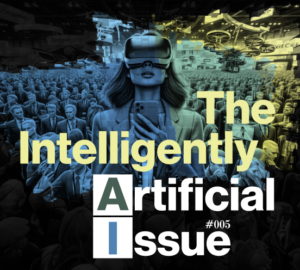Can AI
help
consumers
love
your
brand?
From the editor: Ahead of our CES trip, we held a spirited discussion about the future of brands in the AI era. One of our most provocative discussions centered on the idea that AI functionality can unlock deeper relationships with brands. Is this true? Or are post-purchase activation schemes a rehash of old ideas?
Yes, here's how...
Invest in differentiated activation experiences - with AI’s help.
Think about the brands you trust and love—the ones you rely on to do a job better than any of their competitors. If they’re smart, they’re always looking for ways to grow their relationship with you by becoming more meaningful. The stronger their relationship with you becomes, the greater their margin and pricing power.
True brand power is a high CLTV to CAC ratio and customers who say, to misquote a line from Brokeback Mountain, “I can’t quit you.”
AI WON’T change this reality because we’re human and we want the decision shortcuts brands give us.
AI WILL exacerbate the need for brand relationship building and give brand marketers a powerful tool with which to do it.
AI WILL ALSO muddy the waters for brands fighting for differentiation, and a share of a consumers’ heart and wallet. There is a way around this.
Brands live on a continuum from branded commodities (oatmilk, sugar, etc.) to “n of 1” companies (Instagram, Carta, Slack, Apple, etc.). While AI will impact all of these brands, from their products to how they show up in the world, it’s the brands in the middle for which AI presents the biggest threat… and the biggest opportunity for innovation and relationship building.
The muddy AI water: generative AI for brand differentiation isn’t “all that.”
So, how can brands differentiate in the AI era and how can AI help?
To answer this question, forget about technology and AI for a moment.
Human nature doesn’t change and marketers know what makes consumers tick. They also know their brand’s personality, how it lives in the world and the moments, outside of purchase, where a consumer might find the brand relevant or useful. This is basic brand activation, but done more thoughtfully so a brand can continue to endear itself to the consumer. (And if you’re thinking about activations as “personalized rewards” post-purchase, that’s cool… but that isn’t really this – or it isn’t all of this!)
Brand activation, especially the post-purchase “hours” of 8:00 PM to 12:00 AM on a brand strategy clock, help a brand break free from the sameness of AI-generated digital mind melds and put the consumer at the center to grow the relationship. Using brand activations, marketers can wrest control of AI and use it to their advantage via interactions that unlock contextual customer data and insights, which help marketers ideate ways for a brand to authentically show up in the world and be relevant in ways that extend beyond product use.
Strategic post-purchase brand activation builds a flywheel of engagement, a more efficient allocation of human and financial capital from advertising to brand engagement and, ultimately, to an increase in CLTV/CAC.
In brief, a brand team’s hard-won epiphany of how its brand is differentiated is communicated to the consumer in ways that reinforce past purchase behavior, incentivize repeat purchase behavior, and ideally make the brand part of someone’s life and perhaps their identity.
If you listen to Spotify, you were recently treated to their Wrapped experience. If you fly Delta, you just received a visual summary of all the ways Delta helped you in 2023—your most visited cities, flights, and upgrades. They also reminded you how they could help you in 2024. These weren’t fancy, but they were useful, relevant, and designed to meet the consumer, (me, in this case), where they are beyond the purchase moment.
These examples are only two of the countless ways a brand can authentically have a meaningful activation moment; the best ones will grow their relationship with the consumer. This is where AI insights can help. Traditional and social media channels can do this, but they can be expensive and aren’t designed to deliver the nuanced, relationship building, context that is possible here.
If you know me, you know I’m an early adopter who is always looking for ways to use technology to meet the consumer where they are. I look at AI as a tool to do just that. That said, there is no single “right” way to move forward, but move forward we must. After all, DVDs and CDs used to be billion dollar businesses until new technology came to town.
Even if you’re not 100% sold on the concept of AI-informed post-purchase activations and experiences, I urge you to entertain the possibility. It’s just good business.
Your opportunity
By its very definition, a brand must be differentiated enough from its competitors to outsell its competitors.
To get the desired output of dynamic, differentiated positioning, you need dynamic differentiated input AND an ability to create connections between disparate elements. This is really hard to do—it’s a never-ending battle. There are conference rooms strewn with takeout containers and overfilled trash cans from weary product teams trying to win the war. (Coke vs. Pepsi, anyone?)
Unfortunately, differentiation isn’t enough. Today’s consumer faces a cacophony of SEO-driven messaging and data overload that threatens to water down the positioning born from years of brand research, insights, and takeout containers.
The instinct to use generative AI as a positioning tool shortcut makes sense and yet, it’s risky. Large Language Models (LLMs) are still relatively new and they’re currently processing and converting structured, unstructured, and dark data from everywhere without nuance or a critical eye. In other words, generative AI positioning is a regression to the mean and without a human’s watchful eye can be a melting pot of average.
This article is part of The Intelligently Artificial Issue, which combines two big stories in consumer tech: AI and CES.
Read more from the issue:
USER EXPERIENCE
Augmented Intelligence: from UX to HX
Will prompting replace browsing?
The car is the gateway drug to a voice-first acceleration
The prompt interface needs a redesign
RE-ORG
AI will brainstorm your next reorg
Expect fewer managers and direct-reports
AI is too immature for your business
AI is not a new revolution
BRAND
Should we ignore the hardware?
Can AI help consumers love your brand?
Your brand doesn't have enough data for AI
Can LLMs be optimized like search results?
Good brands will integrate more friction into their C X
Not really
There's no research to confirm customers want relationships with brands.
The first thing I have to say before we get into any debate about the future of AI is that no one knows what will happen. Anyone that gives you a more confident answer to questions is definitely full of shit.
Regarding your perspective: we partially agree on an important point:
My agreement with you comes with a caveat: if we reduced a brand to the values in a manifesto or the colors of a logo, then the averaging out of brands in generative AI experiences would be a problem.
But… that is not how I believe brands work. I believe Byron Sharp’s theory about how brands grow. A brand emerges over time, after the audience embeds its signals in their collective memories. A generative AI model is a reflection of what is already out in the air. I’ve been experimenting with different models and am seeing that many models seem to distinguish between strong brands and vague ones.
We kind of agree that customer-facing generative experiences are homogenizing brand elements.
You place a lot of emphasis on pre and post-purchase activation. I take another angle. Differentiation will come from good creative marketing, which is less common than it should be. Strong brands have been living on the dividends that were paid thirty years ago. Now is the time for creativity. As this technology propagates, more middling brands will elevate their creative output into a generic median – good enough output. Human creativity, augmented by AI capabilities, will further distinguish strong brands from that median.
We also kind of agree that brands need to find a way to distinguish themselves from each other.
You are describing a mass personalization experience across most CPG brands. I’ll just state it like this: there is no research to suggest that consumers want a relationship with brands. The buyers of Crest of Colgate are not interested in joining a social network dedicated to whiter teeth. They buy their respective brands based on the same theories that have driven marketing for generations.
Finally, I do not agree with your point about post-purchase opportunities.
Yes, they do!
Now is the time for brands to invest in differentiated activation experiences - with AI's help.
Noah, you’re right. There are post- purchase activations that are irrelevant, annoying, time consuming, and invasive; no one wants those! Not having insight into how the survey was conducted, my gut is that when people were asked about brand follow-up they had the annoying kind in mind.
To quote Scott Galloway from “No Mercy / No Malice”, “brand is Latin for irrational margin”, and the best ones drive that margin by being omnipresent and meaningful, especially post purchase. It’s a way to reinforce behavior, stay top of mind, and reduce the need to advertise in conventional ways. Brands live everywhere they need to and maintain their margin via post-purchase activation and foundational brand building.
Many of the people who said they didn’t want post-purchase brand engagement probably shop at an Apple store, (itself a form of post-purchase engagement), use the post-purchase activation that is the Genius Bar, and tune into Apple events. In other words, post-purchase activations can be covert and feel seamless, which is probably the best way.
For a covert activation combined with foundational brand building, look at the Tide. Tide’s environmental research efforts, (e.g. cold water washing for the environment), their WWF partnership, product innovation in stain removal, and their“Loads of Hope” community program are all authentic Tide moments and reinforce what people think of Tide, and, what they think of themselves.. They’re done to keep the brand top of mind and psychologically reward purchase. Tide appeals to people’s hearts (we help you save the planet, help others, and keep your, and your family’s, clothes clean).
Tide’s post-purchase activations are subtle and the “distribution channels” are primarily PR and co-branding, (awards such as ”Better Homes and Gardens”) targeted towards their core consumer. Because I’m hard to reach via advertising, and a Tide loyalist, my interaction with the brand was via a Malcom Gladwell podcast about laundry! (highly recommend)
Think too about Lululemon – in-store classes, free hemming, repairs ... consumers WANT this! They just don’t think about these as post-purchase activations, so they would say “no” if asked. And if you’re a baker, King Arthur has done a spectacular job of creating a premium flour brand with their cookbooks and digital resources. (I’m a fan of this brand too!)
The level of activation has to be commensurate with the meaning a brand has in someone’s life and the job it does. It’s even better if it’s seamlessly woven into someone’s life in a relevant way.
For overt activation, think of any automotive brand. The brand is always in touch with you via their app, their service and their special edition mugs (that maybe someone buys!). They also rely on their sales force to help you stay wedded to their brand. Also, for overt but “in service to the consumer,” think Apple, Nike, Nespresso, Disney, Delta, Amex, etc.
Can AI help any of the brand teams behind these and other brands gather insights to continue to elevate? Of course!
P.S. A bit closer to home I just noticed that Piano.io - Analytics & Activation is building out a third space in the Flatiron district of NYC. I have no idea if AI was used to deliver consumer analytics that inspired that brand activation experience, but it could have!
True brand power is a high CLTV to CAC ratio and customers who say, to misquote a line from Brokeback Mountain, “I can’t quit you.”


